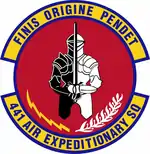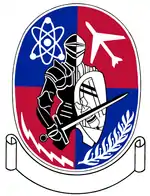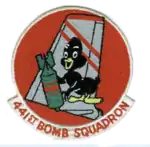441st Air Expeditionary Squadron
The 441st Air Expeditionary Squadron is a provisional United States Air Force unit. It was converted to provisional status in May 2011.
| 441st Air Expeditionary Squadron | |
|---|---|
 Squadron Boeing B-52 dropping bombs in Vietnam[note 1] | |
| Active | 1942–1945; 1947–1949; 1952–1960; 1963–1989 |
| Country | |
| Branch | |
| Role | Expeditionary support |
| Part of | Air Combat Command |
| Motto(s) | Finis Origine Pendet Latin The End Depends on the Beginning |
| Engagements | Mediterranean Theater of Operations[1] |
| Decorations | Distinguished Unit Citation Air Force Outstanding Unit Award French Croix de Guerre with Palm[1] |
| Insignia | |
| 441st Air Expeditionary Squadron emblem (approved 23 January 2018) |  |
| 441st Bombardment Squadron emblem (approved 3 June 1964) |  |
| 441st Bombardment Squadron emblem (approved 7 April 1954)[2] |  |
| 441st Bombardment Squadron emblem (1944-1945)[3] | .png.webp) |
| 441st Bombardment Squadron emblem (1943-1944)[3] | .png.webp) |
Its last assignment as a regular unit was to the 320th Bombardment Wing at Mather Air Force Base, California, where it was inactivated on 30 September 1989.
The squadron was first activated during World War II as the 441st Bombardment Squadron. It served in combat in the Mediterranean Theater of Operations, where it earned two Distinguished Unit Citations and the French Croix de Guerre with Palm. After V-E Day, the squadron returned to the United States for inactivation.
Although briefly active in the reserve from 1947-1949, the squadron was primarily a Strategic Air Command bomber unit, first with Boeing B-47 Stratojets, then with Boeing B-52 Stratofortresses. Although it did not serve as a unit, the squadron was one of the first to deploy aircraft and aircrew for Operation Arc Light missions in Vietnam. The squadron was inactivated in 1989, in connection with the reduction of strategic forces and the closure of Mather.
History
World War II
Established in mid-1942 as a B-26 Marauder medium bomber group. Trained under Third Air Force in Florida, deployed to England under the VIII Air Support Command, 3d Bombardment Wing.
Operated against targets on the continent during early fall of 1942; deployed to North Africa as part of Twelfth Air Force after Operation Torch landings in Algeria in November. Flew tactical bombing missions against Axis forces in North Africa until the end of the Tunisian Campaign in May 1943. Participated in the Sicilian and Italian Campaigns; liberation of Corsica and Sardinia and the Invasion of Southern France. Supported Allied ground forces in the Western Allied Invasion of Germany, spring 1945 and becoming part of the United States Air Forces in Europe Army of Occupation in Germany, fall 1945. Personnel demobilized in Germany and the squadron inactivated as a paper unit in December 1945.
Reserves
Reactivated in the reserves in 1947. Never manned or equipped.
Strategic Air Command bomber operations
Reactivated in 1952 as a Boeing B-47 Stratojet squadron,. Initially equipped with prototypes of the Boeing RB-47B Stratojet (YRB-47) to perform long-range photo-reconnaissance with a flight of Boeing B-29 Superfortress bombers assigned. In November 1953 began to receive production B-47E medium bomber aircraft; prototype reconnaissance aircraft already received exchanged for medium bomber versions. Participated in SAC REFLEX deployments to Europe and North Africa throughout the 1950s. Squadron discontinued, 16 September 1960 and B-47 aircraft sent to storage at Davis-Monthan as part of phaseout of B-47.
Activated as a Boeing B-52 Stratofortress heavy bombardment squadron, absorbing the mission aircraft and personnel of the 72d Bombardment Squadron, which was simultaneously inactivated. Operated B-52Fs until 1968 standing SAC nuclear alert duties, then upgraded to B-52G models. Performed rotational deployments to Western Pacific with B-52Gs, engaging in Operation Arc Light combat missions over Indochina during Vietnam War. Maintained conventional bombing capabilities after end of United States involvement in Vietnam War until inactivation in 1989 as part of retirement of B-52G.
Expeditionary unit
The squadron was converted to provisional status as the 441st Air Expeditionary Squadron and assigned to Air Combat Command to activate as needed.[1]
The 441st Air Expeditionary Squadron reportedly maintains an unpaved runway in Sarrin, Raqqa Governorate.[4][5][6]
Lineage
- Constituted as the 441st Bombardment Squadron (Medium) on 19 June 1942
- Activated on 1 July 1942
- Redesignated 441st Bombardment Squadron, Medium on 9 October 1944
- Inactivated on 6 December 1945
- Redesignated 441st Bombardment Squadron, Light on 26 May 1947
- Activated in the reserve on 9 July 1947
- Inactivated on 27 June 1949
- Redesignated 441st Bombardment Squadron, Medium and activated on 1 December 1952
- Discontinued on 15 September 1960
- Redesignated 441st Bombardment Squadron, Heavy on 15 November 1962 (not organized)
- Organized on 1 February 1963
- Inactivated on 30 September 1989
- Redesignated 441st Air Expeditionary Squadron and converted to provisional status on 13 May 2011[1]
Assignments
- 320th Bombardment Group, 1 July 1942 – 4 December 1945
- 320th Bombardment Group, 9 July 1947 – 27 June 1949
- 320th Bombardment Wing, 1 December 1952
- Strategic Air Command, 15 November 1962 (not organized)
- 320th Bombardment Wing, 1 February 1963 – 30 September 1989
- Air Combat Command to activate or inactivate as needed at any time after 13 May 2011[1]
Stations
|
|
Aircraft
- Martin B-26 Marauder, 1942–1945
- Boeing B-29 Superfortress, 1952–1953
- Boeing YRB-47B Stratojet, 1953
- Boeing B-47 Stratojet, 1953–1960
- Boeing B-52F Stratofortress (1963–1968)
- Boeing B-52G Stratofortress (1968–1989)[1]
References
- Notes
- Aircraft is Boeing B-52F-70-BW Stratofortress serial 57-162, nicknamed "Casper The Friendly Ghost". This aircraft was the first B-52F used to test conventional bombing in 1964, and later dropped the 50,000th bomb of the Arc Light campaign. B-52Fs could carry 51 bombs and served in Vietnam from June 1965 to April 1966 when they were replaced by "Big Belly" B-52Ds which could carry 108 bombs.
- Citations
- Robertson, Patsy (27 March 2018). "Factsheet 441 Air Expeditionary Squadron (ACC)". Air Force Historical Research Agency. Retrieved 9 December 2018.
- Maurer, Combat Squadrons, pp. 545-546
- Watkins, pp. 84-85
- Trevithick, Joseph [@FranticGoat] (6 June 2018). "Lotta interesting stuff happening in this picture, reportedly taken in Syria. Armored forklift loading the MV-22 reportedly belongs to the 441st Air Expeditionary Squadron, which runs the site. h/t @obretix" (Tweet). Archived from the original on 9 June 2018 – via Twitter.
- "441st Air Expeditionary Squadron Civil Engineer Runway Repair". United States Department of Defense. Retrieved 8 June 2018.
- "Pictures: First Seen Ever Images Of Mini US Airbase In Syria's Al-Raqqa". Muraselon. 7 June 2018. Archived from the original on 9 June 2018. Retrieved 9 June 2018.
Nevertheless, opposition media said that the US airbase is located in "Sarrin" in the western countryside of Al-Raqqa.
- Station number in Anderson.
- Station number in Johnson
Bibliography
![]() This article incorporates public domain material from the Air Force Historical Research Agency.
This article incorporates public domain material from the Air Force Historical Research Agency.
- Anderson, Capt. Barry (1985). Army Air Forces Stations: A Guide to the Stations Where U.S. Army Air Forces Personnel Served in the United Kingdom During World War II (PDF). Maxwell AFB, AL yes: Research Division, USAF Historical Research Center. Archived from the original (PDF) on 23 January 2016. Retrieved 28 June 2017.
- Johnson, 1st Lt. David C. (1988). U.S. Army Air Forces Continental Airfields (ETO) D-Day to V-E Day (PDF). Maxwell AFB, AL: Research Division, USAF Historical Research Center. Archived from the original (PDF) on 29 September 2015. Retrieved 26 June 2017.
- Maurer, Maurer, ed. (1983) [1961]. Air Force Combat Units of World War II (PDF) (reprint ed.). Washington, DC: Office of Air Force History. ISBN 0-912799-02-1. LCCN 61060979. Retrieved 17 December 2016.
- Maurer, Maurer, ed. (1982) [1969]. Combat Squadrons of the Air Force, World War II (PDF) (reprint ed.). Washington, DC: Office of Air Force History. ISBN 0-405-12194-6. LCCN 70605402. OCLC 72556. Retrieved 17 December 2016.
- Ravenstein, Charles A. (1984). Air Force Combat Wings, Lineage & Honors Histories 1947-1977. Washington, DC: Office of Air Force History. ISBN 0-912799-12-9. Retrieved 17 December 2016.
- Watkins, Robert A. (2009). Insignia and Aircraft Markings of the U.S. Army Air Force In World War II. Vol. IV, European-African-Middle Eastern Theater of Operations. Atglen, PA: Shiffer Publishing, Ltd. ISBN 978-0-7643-3401-6.
External links
- Reisdorf, Franz (2003). "320th Bomb Group". 320th B. G. Reunion Association. Retrieved 6 July 2017.
- Wong, Kristina (24 June 2013). "High expectations: Fledging Afghan air force pressured for readiness". Washington Times. Retrieved 5 July 2017.
